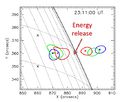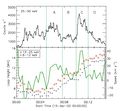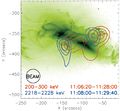RHESSI's Tenth Anniversary
From RHESSI Wiki
m (→Krucker et al.) |
m (→Share et al. (2004)) |
||
| Line 56: | Line 56: | ||
</gallery> | </gallery> | ||
| - | ==== | + | ====Share et al. (2004)==== |
| - | + | ||
| + | Measurement of a surprisingly broad 511-keV positron annihilation line indicating that the temperature of the ion interaction region was above <math>10^5 K</math>. Later, in some flares, the width of the line narrows to ∼1 keV consistent | ||
| + | with annihilation in ionized <math>H at < 10^4 ≥10^{15} cm^{-3}</math>. The full implications of these observations are still unclear but they bring into question the energy source of the heating and if the ions alone can produce such a highly dynamic flaring atmosphere at chromospheric densities that can reach transition-region temperatures, then cool to less than <math>10^4 K</math> in minutes while remaining highly ionized. | ||
| + | |||
| + | RHESSI <math>e^+ -- e^-</math> ANNIHILATION RADIATION OBSERVATIONS: IMPLICATIONS FOR CONDITIONS IN THE FLARING SOLAR CHROMOSPHERE | ||
| + | Gerald H. Share, Ronald J. Murphy, David M. Smith, Richard A. Schwartz, and Robert P. Lin | ||
| + | ApJ, 615:L169–L172, 2004 | ||
| + | |||
| + | Count spectra of the solar 511 keV annihilation line (instrumentally | ||
| + | broadened) derived by subtracting bremsstrahlung and nuclear contributions | ||
| + | during the October 28 flare when the solar line was broad (11:06–11:16 UT) | ||
| + | and narrow (11:18–11:30 UT). The solid curve is the best-fitting model that | ||
| + | includes a Gaussian line and positronium continuum. | ||
Revision as of 17:38, 29 January 2012
Contents |
RHESSI's Scientific Legacy
February 5, 2012, marks the 10the anniversary of RHESSI's launch. At this time, it seems appropriate to review the scientific achievements to date, and here I offer a personal top-ten list of the iconic figures that I think will constitute RHESSI's legacy. A much more comprehensive review of RHESSI's scientific achievements can be found in the recently published Space Science Review (Vol. 159, Issue 1-4) - High-Energy Aspects of Solar Flares: A RHESSI-inspired monograph.
First of all, it is important to remember that RHESSI was designed to combine both X-ray and gamma-ray imaging spectroscopy in a single instrument with the stated goal of investigating particle acceleration and energy release in solar flares. It is natural to breakdown the scientific results into two areas - those relating to the nonthermal electrons producing harder X-ray and gamma-ray continuum emissions, and those relating to the energetic ions that produce gamma-ray emissions. A third area, the hot thermal plasma, has also proved to be productive thanks to the extension of RHESSI's low energy X-ray coverage down to ~3 keV made possible by last minute improvements in the germanium detectors and electronic. I will consider results in these three areas as they reflect the importance in establishing RHESSI's unique contributions to understanding flare energy release and particle acceleration.
Thermal Plasma
Sui and Holman (2003)
The detection of twin X-ray sources in the solar corona with opposite spectral evolution as a function of altitude. This provided the strongest evidence yet for energy release in the corona between the two sources as indicated in Fig. 1
Sui and Holman (2003) also reported the initial downward motion of the coronal X-ray source prior to its previously reported continuous upward motion. This was further detailed by Sui et al. (Sui, Holman, & Dennis 2004, Ap. J., 612, 546), where it was shown (Fig. 2) that the rate of altitude increase correlated with the hard X-ray flux suggesting that it was related to the energy release rate.
Caspi and Lin (2009?)
The location of a superhot X-ray source in the corona and a second cooler thermal source at lower altitudes.
Nonthermal Electrons
Krucker et al.
The detection of nonthermal hard X-rays from high altitude coronal sources.
The observations reflect non-thermal emissions from electrons over a wide range of energies (few keV for double coronal sources, and into the MeV range for the coronal gamma-ray sources. There are clear hints that the coronal hard X-ray sources may have different physics (for example, acceleration mechanisms) in some cases but there is still no real understanding of how they are generated.
Krucker S, Hurford GJ,MacKinnon AL, Shih AY, Lin RP, 2008) "Coronal gamma-ray bremsstrahlung from solar flare-accelerated electrons," ApJL 678:L63–L66, doi:10.1086/588381
Fletcher et al. (2007?)
The detection of multiple footpoint hard X-ray sources and their propagation along flare ribbons.
Accelerated Ions
Hurford et al. (2003 & 2006)
The detection of gamma-ray sources at locations different from the locations of X-ray sources. This is shown for the flare on 2003 Oct. 28 in Fig. ?, where the contours of the gamma-ray and hard X-ray sources are overlaid on a TRACE 195 Angstrom image taken in the same time frame. The implications of this surprising result are still not clear but it implies spatial differences in the acceleration and/or transport of energetic electrons and ions.
Hurford, G. J., Schwartz, R. A., Krucker, S., Lin, R. P., Smith, D. M., & Vilmer, N. 2003, "First Gamma-Ray Images of a Solar Flare," ApJ, 595, L77.
Hurford et al. 2006, "Gamma-Ray Imaging of the 2003 October/November Solar Flares," ApJ, 644: L93–L96.
Measurement of a surprisingly broad 511-keV positron annihilation line indicating that the temperature of the ion interaction region was above Failed to parse (PNG conversion failed; check for correct installation of latex, dvips, gs, and convert): 10^5 K . Later, in some flares, the width of the line narrows to ∼1 keV consistent with annihilation in ionized Failed to parse (PNG conversion failed; check for correct installation of latex, dvips, gs, and convert): H at < 10^4 ≥10^{15} cm^{-3} . The full implications of these observations are still unclear but they bring into question the energy source of the heating and if the ions alone can produce such a highly dynamic flaring atmosphere at chromospheric densities that can reach transition-region temperatures, then cool to less than Failed to parse (PNG conversion failed; check for correct installation of latex, dvips, gs, and convert): 10^4 K
in minutes while remaining highly ionized.
RHESSI Failed to parse (PNG conversion failed; check for correct installation of latex, dvips, gs, and convert): e^+ -- e^-
ANNIHILATION RADIATION OBSERVATIONS: IMPLICATIONS FOR CONDITIONS IN THE FLARING SOLAR CHROMOSPHERE
Gerald H. Share, Ronald J. Murphy, David M. Smith, Richard A. Schwartz, and Robert P. Lin ApJ, 615:L169–L172, 2004
Count spectra of the solar 511 keV annihilation line (instrumentally broadened) derived by subtracting bremsstrahlung and nuclear contributions during the October 28 flare when the solar line was broad (11:06–11:16 UT) and narrow (11:18–11:30 UT). The solid curve is the best-fitting model that includes a Gaussian line and positronium continuum.



